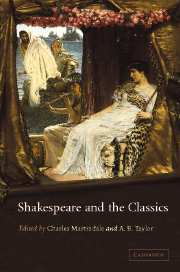Book contents
- Frontmatter
- Contents
- Notes on contributors
- List of abbreviations
- Introduction
- PART I AN INITIAL PERSPECTIVE
- PART II ‘SMALL LATINE’
- PART III ‘LESSE GREEK’
- PART IV THE RECEPTION OF SHAKESPEARE'S CLASSICISM
- 15 ‘The English Homer’: Shakespeare, Longinus, and English ‘neo-classicism’
- 16 ‘There is no end but addition’: the later reception of Shakespeare's classicism
- Select bibliography (compiled by Joanna Paul)
- Index
15 - ‘The English Homer’: Shakespeare, Longinus, and English ‘neo-classicism’
Published online by Cambridge University Press: 22 September 2009
- Frontmatter
- Contents
- Notes on contributors
- List of abbreviations
- Introduction
- PART I AN INITIAL PERSPECTIVE
- PART II ‘SMALL LATINE’
- PART III ‘LESSE GREEK’
- PART IV THE RECEPTION OF SHAKESPEARE'S CLASSICISM
- 15 ‘The English Homer’: Shakespeare, Longinus, and English ‘neo-classicism’
- 16 ‘There is no end but addition’: the later reception of Shakespeare's classicism
- Select bibliography (compiled by Joanna Paul)
- Index
Summary
Discussions of ‘Shakespeare and the Classics’ have generally focused on the influence of classical literature and culture on Shakespeare's writing, whether by considering the general impact on his work of his humanist education, or his responses to particular classical authors and themes. Such, indeed, is the emphasis of the earlier chapters of this book. But ‘Shakespeare and the Classics’ is a topic which also has resonances for students of the afterlife and reception of Shakespeare's work. In ‘Tradition and the Individual Talent’, T. S. Eliot famously observed that
No poet, no artist of any art, has his complete meaning alone. His significance, his appreciation is the appreciation of his relation to the dead poets and artists. You cannot value him alone; you must set him, for contrast and comparison, among the dead. I mean this as a principle of aesthetic, not merely historical, criticism.
Eliot's main concern was the way in which the appearance of a new work of art inevitably affects readers' appreciation of all the works of art which preceded it. ‘What happens when a new work of art is created,’ he argued,
is something that happens simultaneously to all the works of art which preceded it. The existing monuments form an ideal order among themselves, which is modified by the introduction of the new (the really new) work of art among them.
A reader sympathetic to such ideas, Eliot believed, would ‘not find it preposterous that the past should be altered by the present as much as the present is directed by the past’.
- Type
- Chapter
- Information
- Shakespeare and the Classics , pp. 261 - 276Publisher: Cambridge University PressPrint publication year: 2004
- 2
- Cited by



